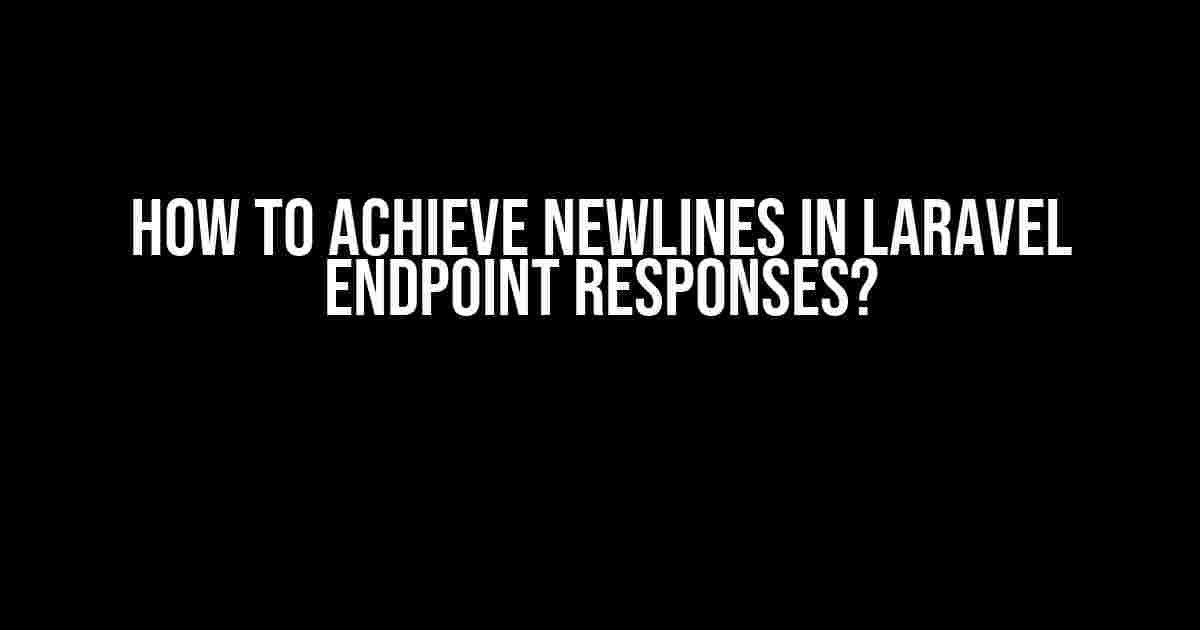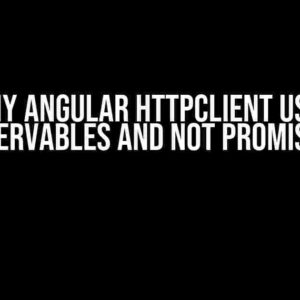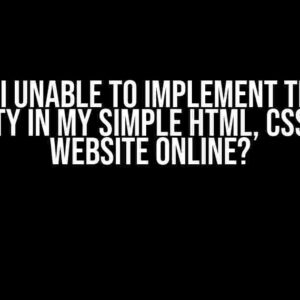Are you tired of wrestling with Laravel’s response formatting, desperately trying to inject a simple newline character into your API responses? Fear not, dear developer! In this article, we’ll explore the various ways to achieve newlines in Laravel endpoint responses, because, let’s face it, a well-formatted response is a happy response.
The Problem: Laravel’s Default Response Formatting
Laravel, by default, strips newline characters from response outputs. This is due to its reliance on the `Illuminate\Support\Facades\Response` facade, which, by design, trims excess whitespace. While this behavior is useful in most cases, it can lead to headaches when you need to maintain readability in your API responses.
Why Do We Need Newlines in Laravel Endpoint Responses?
Newlines in API responses serve several purposes:
- Readability**: Newlines improve the readability of your API responses, making it easier for developers to debug and understand the data.
- Data Organization**: Newlines help to visually separate data, reducing the likelihood of confusion and errors.
- Platform Compatibility**: Some platforms, like iOS, require newline characters to correctly parse and display data.
Solution 1: Using the `json` Method with the `JSON_PRETTY_PRINT` Option
In Laravel 5.5 and later, you can use the `json` method to return a JSON response with newlines. By setting the `JSON_PRETTY_PRINT` option, you can force Laravel to include newline characters in the response output.
Route::get('/api/response', function () {
$data = [
'name' => 'John Doe',
'email' => '[email protected]',
'address' => '123 Main St'
];
return response()->json($data, 200, [], JSON_PRETTY_PRINT);
});
In this example, the `JSON_PRETTY_PRINT` option is set to include newline characters and indentation in the JSON response.
Solution 2: Using a Custom Response Macro
If you prefer a more flexible approach, you can create a custom response macro to format your responses with newlines. In this example, we’ll create a `prettyJson` macro:
// In your AppServiceProvider's boot method
use Illuminate\Support\Facades\Response;
Response::macro('prettyJson', function ($data) {
return json_encode($data, JSON_PRETTY_PRINT);
});
// In your controller or route
Route::get('/api/response', function () {
$data = [
'name' => 'John Doe',
'email' => '[email protected]',
'address' => '123 Main St'
];
return response()->prettyJson($data);
});
This custom macro allows you to easily format your responses with newlines, while maintaining the flexibility to customize the output as needed.
Solution 3: Using a Middleware to Format Responses
Alternatively, you can create a middleware to format responses with newlines. This approach provides a more global solution, allowing you to apply the formatting to all responses or specific routes.
// Create a new middleware class (e.g., PrettyJsonMiddleware)
namespace App\Http\Middleware;
use Closure;
use Illuminate\Support\Facades\Response;
class PrettyJsonMiddleware
{
public function handle(Request $request, Closure $next)
{
$response = $next($request);
if ($response->headers->get('Content-Type') === 'application/json') {
$content = json_encode(json_decode($response->getContent(), true), JSON_PRETTY_PRINT);
$response->setContent($content);
}
return $response;
}
}
// Register the middleware in your kernel
protected $middleware = [
// ...
\App\Http\Middleware\PrettyJsonMiddleware::class,
];
// In your controller or route
Route::get('/api/response', function () {
$data = [
'name' => 'John Doe',
'email' => '[email protected]',
'address' => '123 Main St'
];
return response()->json($data);
});
This middleware will format all JSON responses with newlines, providing a convenient and maintainable solution for your API.
Solution 4: Using a Third-Party Package (Fractal)
If you’re already using the Fractal package in your Laravel application, you can leverage its built-in support for pretty-printing JSON responses.
use League\Fractal\Manager;
use League\Fractal\Paginator\IlluminatePaginatorAdapter;
use League\Fractal\Resource\Collection;
use App\Models\User;
$users = User::all();
$fractal = new Manager();
$resource = new Collection($users, new UserTransformer);
$paginator = new IlluminatePaginatorAdapter($users);
return response()->json($fractal->createData($resource)->toArray(), 200, [], JSON_PRETTY_PRINT);
Fractal’s `toArray` method will automatically format the response with newlines, making it an attractive option if you’re already invested in the package.
Conclusion
In conclusion, achieving newlines in Laravel endpoint responses is a relatively straightforward process, with multiple solutions to suit your needs. Whether you opt for the built-in `json` method, a custom response macro, a middleware, or a third-party package like Fractal, you’ll be well on your way to crafting beautifully formatted API responses that bring joy to the eyes of developers everywhere.
| Solution | Description | Advantages | Disadvantages |
|---|---|---|---|
json method with JSON_PRETTY_PRINT |
Use the built-in json method with the JSON_PRETTY_PRINT option. |
Easy to implement, works out of the box. | Limited customization options. |
| Custom Response Macro | Create a custom response macro to format responses with newlines. | Flexible and customizable, can be reused across the application. | Requires additional code and setup. |
| Middleware | Create a middleware to format responses with newlines. | Global solution, can be applied to all routes or specific routes. | May add overhead, requires additional code and setup. |
| Third-Party Package (Fractal) | Use a third-party package like Fractal to format responses with newlines. | Already integrated with Laravel, provides additional features. | Requires additional package installation and setup. |
Choose the solution that best fits your needs, and start crafting beautiful API responses with newlines today!
Frequently Asked Question
In Laravel, achieving newlines in endpoint responses can be a daunting task, especially for developers new to the framework. But fear not, dear developer, for we’ve got you covered! Here are the top 5 questions and answers on how to get those pesky newlines to work in your Laravel endpoint responses.
Why aren’t my newlines showing up in my JSON responses?
By default, Laravel’s JSON responses don’t render newlines as they’re considered whitespace. To get around this, you can use the nl2br() helper function to convert newlines to HTML line breaks (return response()->json(['message' => nl2br($message)]);. Voilà! Your newlines should now be displayed in your JSON response.
Can I use \n or \r\n to add newlines to my response?
You can indeed use Unicode escape sequences like \n or \r\n to add newlines to your response string. However, when using these, keep in mind that the resulting JSON response will contain the actual Unicode characters, not the raw newlines. This might not be what you want, especially if you’re working with a client that expects raw newlines. Stick with the nl2br() function for a more reliable approach.
Will Laravel’s Str::macro() help me with newlines in responses?
While Laravel’s Str::macro() can be a powerful tool for string manipulation, it won’t directly help you with newlines in responses. However, you can use it to create a custom macro that wraps your response string with the nl2br() function. For example: Str::macro('withNewlines', function ($str) { return nl2br($str); });. Then, in your controller, you can use the macro like so: return response()->json(['message' => Str::withNewlines($message)]);.
Can I use a middleware to handle newlines in responses?
You can indeed create a middleware to handle newlines in responses. This approach can be useful if you need to handle newlines across multiple controllers or responses. In your middleware, you can use the nl2br() function to convert newlines to HTML line breaks. Simply register the middleware in your kernel, and it will be applied to all responses. Neat, huh?
Are there any alternatives to using nl2br() for newlines in Laravel responses?
While nl2br() is a reliable approach, you can also use the strip_tags() function in combination with the
HTML tag to preserve newlines in your response. This method works especially well when you need to display code snippets or formatted text in your response. Simply wrap your response string with thetag and usestrip_tags()to remove any unwanted HTML tags.





